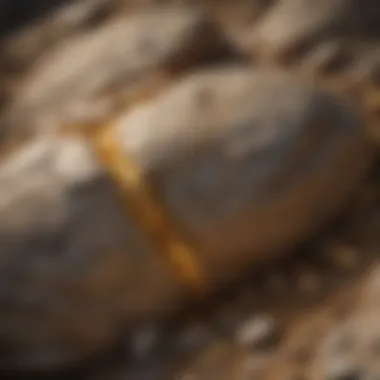Unveiling the Intricacies of Gold Extraction from Rock


Rock and Fossile Identification
The initial step in the complex process of extracting gold from rocks involves identifying the rocks and fossils where this precious material is embedded. Understanding the types of rocks and fossils commonly associated with gold is crucial. Various characteristics must be carefully observed during this stage, such as color, texture, and structure. Specialized tools, including hammers, chisels, and magnifying glasses, are utilized for close inspection and identification purposes.
Collection Tipes and Techniques
Moving on to collecting tips and techniques, it is essential to follow best practices to ensure successful extraction of gold-rich rocks. Geological knowledge plays a significant role in locating prime sites for collecting. Geologists recommend focusing on areas with specific geological features indicative of gold deposits. Once a suitable site is identified, it is crucial to extract specimens safely and effectively, using techniques that minimize damage to the rocks and maximize the recovery of gold particles.
Preservation and Disolay
Preservation and display are critical aspects of the process, especially for valuable gold-containing rocks. Various preservation techniques, such as sealing specimens in protective coatings or storing them in controlled environments, help prevent deterioration over time. Proper storage methods involve using containers that shield the rocks from environmental factors that can degrade them. When it comes to display, creativity knows no bounds. From elegant stands to informative labels, there are numerous ways to showcase rocks and fossils in a visually appealing and educational manner.
Geological Insights
Delving into geological insights, it is essential to understand the formation processes that led to the creation of gold-bearing rocks. Examining the historical significance of these rocks unveils a rich tapestry of past mining endeavors and scientific discoveries. Notable findings in the field of geology shed light on the immense potential for further exploration and the continued study of rocks and fossils for their hidden treasures.
Introduction
Understanding the Geological Composition
The Formation of Gold Deposits
The formation of gold deposits is a fundamental aspect in the process of extracting gold from rock. Understanding the geological processes that lead to the concentration of gold deposits is vital for pinpointing potential mining sites. Gold deposits are often formed through a combination of geological events such as tectonic activity, hydrothermal processes, and sedimentary accumulation. The unique characteristic of gold's association with specific geological formations makes it an attractive choice for extraction. While the formation of gold deposits presents lucrative opportunities for mining, it also poses challenges such as variability in deposit concentrations and complexities in extraction techniques.
Identifying Rock Types Associated with Gold
Identification of rock types associated with gold is another crucial element in the extraction process. Rocks hosting gold deposits exhibit distinctive mineralogical, structural, and textural characteristics that mark them as favorable for gold extraction. These rock types include quartz veining, schist formations, and altered granites, among others. The unique feature of these rock types lies in their capacity to store and release gold under specific geological conditions. However, the identification of such rock types demands a keen eye for geological patterns and extensive knowledge of mineral assemblages. While these rock types offer advantages in holding vast quantities of gold, their extraction may be complicated by factors such as depth, accessibility, and metallurgical challenges.
Exploration and Prospecting


Mapping Potential Mining Sites
The mapping of potential mining sites plays a pivotal role in the exploration phase of gold extraction. By delineating geological features, prospective mineralization zones, and structural attributes of the terrain, mapping enables geologists to identify areas with high gold mineralization potential. Utilizing various mapping techniques including geological mapping, geochemical surveys, and remote sensing technologies, geologists can create comprehensive models of mineral distribution. The key advantage of mapping potential mining sites lies in its ability to narrow down target areas for detailed exploration, thus optimizing resource allocation and minimizing exploration risks. However, challenges such as topographical complexities, limited accessibility, and environmental regulations may influence the effectiveness of mapping techniques.
Geophysical Surveys
Geophysical surveys constitute another essential component of gold exploration and prospecting. These surveys involve the measurement and analysis of the earth's physical properties, such as electrical conductivity, magnetic susceptibility, and density variations. By interpreting geophysical data collected through techniques like ground-penetrating radar, induced polarization, and magnetometry, geologists can infer subsurface geological structures and potential ore bodies. The advantage of geophysical surveys lies in their ability to provide non-invasive and high-resolution images of the subsurface, aiding in target selection and drill planning. However, limitations such as depth penetration, resolution constraints, and data interpretation challenges may affect the reliability of geophysical survey results.
Drilling and Sampling Techniques
Core Drilling
Core drilling stands as a key method in the physical extraction of ore samples for gold exploration. This technique involves drilling cylindrical core samples from underground formations to assess mineralization patterns and geological structures. Core drilling allows geologists to obtain vital information on ore grades, continuity, and spatial distribution within the deposit. The unique feature of core drilling lies in its ability to provide direct geological data from the subsurface, offering valuable insights for mine planning and resource estimation. While core drilling offers advantages in precise sampling and depth penetration, challenges such as drilling costs, logistical constraints, and operational safety considerations may impede its efficiency.
Assessment of Ore Samples
The assessment of ore samples forms an integral part of the mineral exploration process in gold extraction. By analyzing physical, chemical, and mineralogical properties of ore samples, geologists can determine the viability and economic potential of a deposit. Techniques such as ore microscopy, X-ray fluorescence, and fire assay are commonly employed to evaluate ore composition and grade. The unique feature of ore sample assessment lies in its role in quantifying gold content, determining extraction methods, and optimizing processing techniques. While ore sample assessment offers advantages in accurate resource evaluation and grade estimation, challenges such as sample representativeness, analytical errors, and sample preparation issues may impact the reliability of assessment results.
Extraction Process
The Extraction Process holds significant importance in this article as it forms the core of turning rock into valuable gold. Understanding the intricacies of Extraction Process is crucial for anyone interested in the mining industry. Every step, from crushing and grinding to chemical leaching and separation techniques, plays a vital role in successfully extracting gold from the rock. The efficiency and precision of the Extraction Process determine the yield of gold from the ore, making it a pivotal aspect to discuss in detail.
Crushing and Grinding
Milling the Ore
Delving into the process of Milling the Ore is indispensable when extracting gold from the rock. Milling involves breaking down the ore into smaller pieces to facilitate further processing. One key characteristic is the ability to control the size reduction of the ore, which is critical for achieving optimal results during subsequent stages of extraction. Milling the ore is a popular choice due to its proven effectiveness in ensuring a uniform particle size, enhancing the overall efficiency of the extraction process. Despite its benefits, one notable disadvantage is the significant energy consumption associated with milling activities in this article.
Comminution Processes
Examining the Comminution Processes sheds light on another essential aspect of gold extraction. Comminution involves reducing the ore size through crushing and grinding operations. A key characteristic of Comminution Processes is the ability to liberate the valuable minerals from the ore matrix, improving the recovery rate of gold. This method is favored for its versatility and effectiveness in treating various types of ores efficiently. However, a potential disadvantage of Comminution Processes is the generation of fine particles that may lead to additional processing challenges in this article.


Chemical Leaching
Cyanidation Method
The Cyanidation Method is a cornerstone of modern gold extraction processes and plays a crucial role in this article. Utilizing cyanide solutions to dissolve gold from the ore demonstrates a key characteristic of rapid dissolution, ensuring high recovery rates of gold. Cyanidation is a popular choice due to its simplicity and effectiveness in treating low-grade ores. However, a significant disadvantage associated with the Cyanidation Method is its environmental impact, prompting the industry to explore alternatives in this article.
Alternative Leaching Agents
Exploring Alternative Leaching Agents offers a glimpse into innovative methods of gold extraction. These agents provide environmentally friendly alternatives to cyanide-based processes. A key characteristic of Alternative Leaching Agents is their ability to effectively leach gold from the ore while minimizing environmental risks. The use of alternative agents is gaining popularity due to the focus on sustainable mining practices. Nonetheless, challenges such as higher operational costs may pose a potential disadvantage in this article.
Separation and Recovery
Gravity Separation
Gravity Separation stands out as a fundamental method for separating gold from the ore matrix. This technique capitalizes on variations in particle density to achieve separation, without the need for chemicals. A key characteristic of Gravity Separation is its cost-effectiveness and ability to recover coarse gold particles efficiently. The simplicity and adaptability of this method make it a popular choice for initial gold recovery. However, limitations in the separation of fine particles may be considered a drawback in this article.
Flotation Techniques
Delving into Flotation Techniques unveils a sophisticated approach to separating gold from the ore. By utilizing differences in surface properties, flotation processes enable the selective attachment of air bubbles to gold particles. A key characteristic of Flotation Techniques is their versatility in treating complex ore types with varying mineral compositions. This method is favored for its high recovery rates and ability to produce high-quality concentrates. Despite its advantages, operational complexities in controlling flotation parameters may present challenges within this article.
Environmental Considerations
When delving into the extraction of gold from rock, it is imperative to underscore the critical significance of environmental considerations. The very essence of responsible mining practices lies in the thorough understanding and application of environmental considerations throughout the mining process. The meticulous evaluation and integration of these factors not only ensure sustainable operations but also minimize the ecological impact of mining activities.
Safeguarding the environment against undue harm and degradation is paramount in the realm of extraction projects. By prioritizing environmental considerations, mining entities can actively mitigate potential risks and uphold ecological balance. The intrinsic link between mining operations and the environment necessitates a conscientious approach toward sustainability and environmental stewardship. Therefore, addressing environmental considerations is not merely a choice but a fundamental obligation in modern mining practices.
Mitigation Measures play a pivotal role in upholding the core ethos of environmental considerations. These measures encompass a range of strategies aimed at reducing the adverse effects of mining activities on the environment. By implementing Mitigation Measures effectively, mining companies can offset environmental consequences, preserve biodiversity, and promote sustainable resource management.
In the context of this article, Mitigation Measures stand out as a proactive approach to environmental responsibility. Their adaptability and efficacy in curbing environmental impacts underscore their prominent position in the realm of responsible mining. The systematic application of Mitigation Measures serves as a shield against ecological harm, reflecting a concerted effort toward ethical and sustainable mining practices.
On the other hand, Rehabilitation of Mining Sites serves as a vital component in the restoration and revitalization of post-mining landscapes. Through systematic planning and execution, the rehabilitation process aims to reclaim disturbed land and foster ecosystem regeneration. By focusing on rehabilitating mining sites, companies can rectify environmental disruption and promote the recovery of local habitats.


In the context of this article, the Rehabilitation of Mining Sites emerges as a beacon of hope in the post-mining scenario. Its emphasis on restoring ecological balance and promoting environmental recovery highlights its indispensable role in sustainable mining endeavors. The unique feature of Rehabilitation of Mining Sites lies in its capacity to restore ecosystems to a semblance of their former state, underscoring the long-term commitment to environmental preservation.
Sustainable Practices
As we navigate the intricate landscape of gold extraction from rock, the adoption of sustainable practices emerges as a cornerstone of responsible mining. Sustainable practices encapsulate a spectrum of techniques and methodologies aimed at minimizing environmental impact and maximizing resource efficiency. By adhering to sustainable practices, mining operations can align profitability with environmental stewardship, creating a harmonious coexistence between industry and ecology.
Reducing Environmental Footprint arises as a key facet of sustainable practices, emphasizing the imperative to minimize the ecological burden of mining activities. By streamlining processes, optimizing resource use, and reducing emissions, the strategy of reducing environmental footprint fosters eco-conscious mining operations. This approach not only enhances operational efficiency but also underscores a commitment to environmental sustainability.
In the context of this article, Reducing Environmental Footprint takes center stage as a catalyst for greener mining initiatives. Its focus on efficiency and eco-friendliness aligns with the overarching theme of responsible resource extraction. The unique feature of Reducing Environmental Footprint lies in its ability to drive continuous improvement in environmental performance, setting a new standard for eco-aware mining practices.
Concurrently, Adopting Eco-Friendly Technologies signifies a proactive shift toward sustainable mining methodologies. By harnessing innovative technologies and green energy solutions, mining ventures can reduce their carbon footprint and minimize environmental degradation. The integration of eco-friendly technologies not only improves operational sustainability but also paves the way for future-forward mining practices.
In the context of this article, Adopting Eco-Friendly Technologies represents a paradigm shift toward environmentally conscious mining strategies. Its emphasis on technological innovation and environmental compatibility underscores a progressive approach to resource extraction. The unique feature of Adopting Eco-Friendly Technologies lies in its capacity to harmonize technological advancement with ecological preservation, promising a greener future for the mining industry.
Challenges and Innovations
Challenges and Innovations play a vital role in the field of extracting gold from rock, offering valuable insights into the advancements and obstacles faced by industry professionals. Within this article, the delineation of Challenges and Innovations provides a nuanced understanding of the dynamic landscape of gold extraction, shedding light on areas where innovation drives progress and challenges necessitate novel solutions. By exploring technological advancements and regulatory hurdles, this section dives deep into the complexities that define the domain of gold extraction.
Technological Advancements
Automation in Mining
Automation in Mining emerges as a pivotal aspect of revolutionizing the extraction process, introducing efficiency and precision to operations. The key characteristic of Automation in Mining lies in its ability to streamline repetitive tasks, enhance safety protocols, and optimize production output significantly. Its integration within gold extraction processes is increasingly favored due to its capacity to minimize human error, reduce operational costs, and accelerate the overall extraction timeline. Automation in Mining's unique feature lies in its adaptability across various mining scales, catering to both large-scale mining operations and artisanal miners seeking enhanced productivity. While Automation in Mining brings unparalleled benefits in terms of increased productivity and safety, potential disadvantages revolve around initial setup costs and technological dependencies inherent in its implementation within the gold extraction sector.
Nanotechnology Applications
Nanotechnology Applications represent a cutting-edge approach in the realm of gold extraction, leveraging nanoscale materials to enhance efficiency and recovery rates. The key characteristic of Nanotechnology Applications lies in their ability to target specific gold particles at the molecular level, facilitating a more precise and sustainable extraction process. This innovation stands as a popular choice for this article due to its capacity to mitigate environmental impacts, optimize resource utilization, and improve overall extraction yields. Nanotechnology Applications' unique feature lies in their nanoparticle design, which enables selective binding to gold particles and enhances separation processes effectively. While offering substantial advantages in terms of efficiency and environmental sustainability, potential disadvantages of Nanotechnology Applications may revolve around regulatory approvals, operational scale-up challenges, and the disposal of nanomaterials within extraction sites.
Regulatory Hurdles
Compliance with Mining Regulations
Compliance with Mining Regulations emerges as a crucial aspect shaping the ethical and legal framework of gold extraction practices, ensuring adherence to established guidelines and standards. The key characteristic of Compliance with Mining Regulations lies in its mandate to promote environmental protection, community engagement, and sustainable resource management within mining operations. Considering its beneficial impact on the industry, Compliance with Mining Regulations becomes a preferred choice for this article as it underscores the importance of ethical conduct and environmental responsibility in gold extraction ventures. The unique feature of Compliance with Mining Regulations lies in its enforcement through monitoring mechanisms, audits, and stakeholder consultations, fostering transparency and accountability within the extraction process. While yielding advantages such as enhanced environmental stewardship and social license to operate, potential disadvantages of Compliance with Mining Regulations might involve administrative burdens, compliance costs, and regulatory uncertainties inherent in the evolving landscape of mining governance.
Ethical Mining Practices
Ethical Mining Practices stand at the forefront of promoting sustainable and socially responsible approaches to gold extraction, prioritizing fair labor practices, community empowerment, and ethical supply chains. The key characteristic of Ethical Mining Practices lies in their commitment to upholding human rights, labor standards, and sustainable development goals within mining operations. Chosen for its alignment with ethical principles and sustainable values, Ethical Mining Practices serve as an integral component of this article, highlighting the significance of responsible mining practices within the gold extraction sector. The unique feature of Ethical Mining Practices lies in their emphasis on transparency, accountability, and collaboration with local communities, fostering long-term positive impacts and mutual benefits. While offering advantages such as improved societal relations, risk mitigation, and brand reputation enhancement, potential disadvantages of Ethical Mining Practices may pertain to additional operational costs, stakeholder management complexities, and the need for continuous monitoring and compliance verification.







